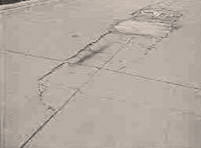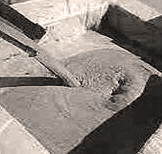Performance Properties
Compressive Strength
 Flowable fill mixtures are usually specified to meet either a compressive strength or unit weight requirement. The compressive strength is typically measured by testing a 4 x 8 inch cylindrical test specimen in compression. The National Ready Mixed Concrete Association defines an "excavatable" flowable fill mixture as one with a compressive strength not exceeding 150 pounds per square inch. Mixtures exceeding this strength have also been known to be excavatable with the use of mechanical equipment. However, prior tests proving ease of excavatability should be made prior to final placement. Measuring the bearing capacity of the in-place flowable fill by using a penetrometer has proven to be a more accurate method providing consistent results in comparison to measuring the compressive strength.
Flowable fill mixtures are usually specified to meet either a compressive strength or unit weight requirement. The compressive strength is typically measured by testing a 4 x 8 inch cylindrical test specimen in compression. The National Ready Mixed Concrete Association defines an "excavatable" flowable fill mixture as one with a compressive strength not exceeding 150 pounds per square inch. Mixtures exceeding this strength have also been known to be excavatable with the use of mechanical equipment. However, prior tests proving ease of excavatability should be made prior to final placement. Measuring the bearing capacity of the in-place flowable fill by using a penetrometer has proven to be a more accurate method providing consistent results in comparison to measuring the compressive strength.
Unit Weight
Just as with compressive strength, flowable fill mixtures may be designed to obtain a wide range of unit weights. The unit weight of flowable fill mixtures typically ranges between 70 and 145 pounds per cubic foot. However, the use of special chemical admixtures for flowable fill mixtures can reduce the unit weight to as low as 20 pounds per cubic foot for applications requiring minimal loading conditions.
Flowability
 Just as the name "flowable fill" suggests, these mixtures may be designed to vary from that of a stiff to a very fluid and flowable consistency. The flowability of the mixture provides numerous advantages over traditional compacted soil or granular fill. Typically, flowable fill mixtures are designed to have a high rate of flowability, enabling the material to be self-leveling and selfcompacting without the use of mechanical compacting equipment. Two major considerations in using highly flowable mixtures are the hydrostatic pressure and buoyancy effects: Placing the flowable fill in lifts, with each lift allowed to harden prior to the next placement, will reduce hydrostatic pressure. Situations that do not allow the contractor to anchor the pipe to counter the buoyancy effects may require a flowable fill mixture of a stiff consistency until the pipe is encapsulated and then completed with a more fluid mixture.
Just as the name "flowable fill" suggests, these mixtures may be designed to vary from that of a stiff to a very fluid and flowable consistency. The flowability of the mixture provides numerous advantages over traditional compacted soil or granular fill. Typically, flowable fill mixtures are designed to have a high rate of flowability, enabling the material to be self-leveling and selfcompacting without the use of mechanical compacting equipment. Two major considerations in using highly flowable mixtures are the hydrostatic pressure and buoyancy effects: Placing the flowable fill in lifts, with each lift allowed to harden prior to the next placement, will reduce hydrostatic pressure. Situations that do not allow the contractor to anchor the pipe to counter the buoyancy effects may require a flowable fill mixture of a stiff consistency until the pipe is encapsulated and then completed with a more fluid mixture.
Permeability
The measure of the rate at which water or gas passes through a backfill material is defined as its permeability. The versatility in design of flowable fill mixtures to obtain varying rates of permeability provides numerous advantages over site material or granular material transported to the site. In general applications, designing flowable fill mixtures to have a minimum permeability equal to that of a uniform fine sand (4.0 x 10-1 cm/sec) is recommended. Applications such as backfilling gas lines or areas where the hydrology of the surrounding areas may be of concern, recommendations from an engineer regarding the coefficient of permeability should be obtained.
Settlement & Subsidence
 Flowable fill does not settle once it has reached its hardened state. Hardening time is greatly influenced by numerous factors including mix composition, properties of the surrounding soil, ambient temperature, and volume of placement. Mixtures have been designed to harden within 1 hour in applications where future excavation is not required, but under normal conditions generally takes 3 to 5 hours. Subsidence is a reduction in volume of the plastic mixture as a direct result of loss of water and entrapped air as the mixture selfconsolidates during the placement process. Typically, subsidence of 1/8inch per foot of depth is experienced. The use of chemical flowable fill admixtures will typically reduce subsidence.
Flowable fill does not settle once it has reached its hardened state. Hardening time is greatly influenced by numerous factors including mix composition, properties of the surrounding soil, ambient temperature, and volume of placement. Mixtures have been designed to harden within 1 hour in applications where future excavation is not required, but under normal conditions generally takes 3 to 5 hours. Subsidence is a reduction in volume of the plastic mixture as a direct result of loss of water and entrapped air as the mixture selfconsolidates during the placement process. Typically, subsidence of 1/8inch per foot of depth is experienced. The use of chemical flowable fill admixtures will typically reduce subsidence.
Thermal Insulation & Conductivity
Generally, flowable fill mixtures do not exhibit good insulating properties. However, the use of special chemical admixtures and lightweight aggregates greatly reduces the density of the mixture and increases its insulting properties. Applications such as backfill for power cables often require mixtures to be designed with a relatively high density and low porosity to ensure conductivity. Unlike compacted soils or granular fill, flowable fill may be designed to obtain a wide range of density values and therefore provide greater options for the engineer.
Excavatability
 Excavatability is an important consideration while proportioning a flowable fill mixture. Excavatable flowable fill has been defined as having an unconfined compressive strength of 150 psi or less. Strengths exceeding this limit can be excavated using mechanical equipment, depending on the mix composition and the equipment. Due to the continued strength-gaining characteristics of component materials such as fly ash and slag, excavatability of mixtures exceeding 150 psi should be proven prior to final placement.
Excavatability is an important consideration while proportioning a flowable fill mixture. Excavatable flowable fill has been defined as having an unconfined compressive strength of 150 psi or less. Strengths exceeding this limit can be excavated using mechanical equipment, depending on the mix composition and the equipment. Due to the continued strength-gaining characteristics of component materials such as fly ash and slag, excavatability of mixtures exceeding 150 psi should be proven prior to final placement.


